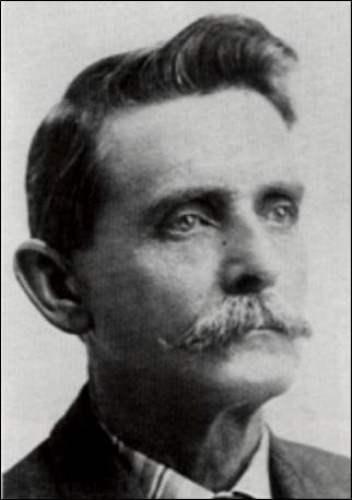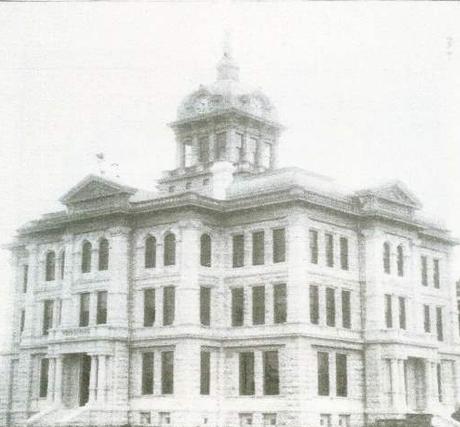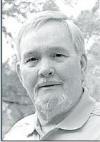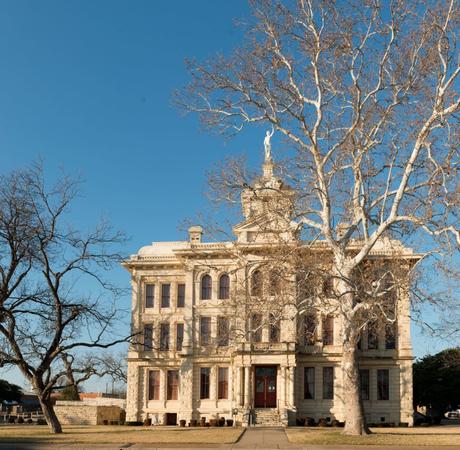Shaun Cooks is a Texas inmate convicted of firing two shots at a sheriff’s deputy. Cooks says he didn’t have a gun with him that night. You can find the entire series here.
The Milam County Courthouse was 110 years old when Shaun Cooks was tried there. When the gracious old building was renovated a decade before the trial, a bullet hole was left in the front door. A commemorative plaque explains how it got there. On June 20th, 1905, Milam Sheriff Bob Todd gunned down ex-sheriff Giles Avriett after the two men quarreled.

Todd walked calmly to the jailhouse and surrendered to a constable. The killer claimed self-defense but refused to give a statement. After spending five months in the county jail, Todd was tried by a jury of his peers. In the right hands, the evidence against him might have been damning. According to some reports, Avriett had been shot in the back and there was no gun in his possession when his body was found. But after a week-long trial featuring 60 witnesses, Todd was quickly acquitted. He served out the rest of his two-year term. Todd was popular in the community. Even the prosecutor was pleased with the outcome.
In November of 1907, Todd was involved in the community’s next big incident when Alex Johnson was indicted for “intent to commit a criminal assault”. Johnson was a Black man; his alleged victim was white.
It is difficult to piece together the details of the case. The victim is variously described as “a young woman” and “a young girl”. According to Grand Jury testimony, Johnson saw her walking down a public road one day and decided to wait around until she returned. At that point, he pulled out a handgun and would have assaulted her had she not wriggled free.
The indictment was read and Johnson was led from the courthouse to the jail house. Only then the public discover that, since the defendant had been unable to carry out his evil design, the death penalty was off the table. This also meant that Johnson would have to defend himself at trial since, prior to 1963, defense counsel was commonly assigned only in capital cases.
But, suppose that Mr. Johnson had been assigned an attorney. Would the man have dared call alibi witnesses? Could he have asked, for instance, how a young girl was able to escape from an armed man? And, if a defense attorney had asked such questions, would he have made it out of town alive?
We will never know. A crowd of 500 had gathered from every corner of Milam County to see that justice was done. When it was announced that the suspect wouldn’t die for his sins, “an angry mob of infuriated citizens” marched to the county jail armed with rifles and sledgehammers.
According to newspaper reports, ex-sheriff Robert Todd, saw the mob approaching. While the sheriff he wired the governor for help, Todd summoned a group of leading citizens to help him protect his prisoner. According to press reports, Todd was out of his depth. “Like the swollen stream of a mountain, the crowd was invincible. The doors were so battered that the locks were broken and entrance effected. The crowd rushed upstairs, led by gray-haired men, and it meant death to many good citizens to save the negro, for it was plain that these men meant to have the negro at any cost.”
The governor sent out a militia from Austin to intervene, but “too late to save the negro’s neck.”
I should note, before proceeding, that “negro” (lower case) was commonly used in the Jim Crow South instead of “Negro” (upper case) as a nod to white supremacy.
Johnson was seized by the mob and dragged to the “execution tree” a few feet from the courthouse, “and there he swung until he was dead.”

The crowd, we are told, was “orderly” and, as typically happened after a lynching, dispersed without further incident.
It is possible, even likely, that the crowd did far more to poor Mr. Johnson than is apparent in contemporary newspaper accounts. Lynching typically involved torture and, not infrequently, burning at the stake.
Was what happened to Shaun Cooks in the Milam County Courthouse all that different from Alex Johnson’s lynching? If so, was the difference in kind, or merely in degree?
What if Shaun had been forced to undertake his own defense? Things couldn’t possibly have gone worse? And, since Shaun Cooks is far more determined and resourceful than your average defendant, the case might have turned out very differently.
Everyone knows there was a gun used
The trial of JeJuan Shauntel Cooks began on March, 2011 with the defendant’s motion to fire his attorney.
Judge Ed Magre, denied the motion. Cooks was on his second court-appointed attorney and the case had been repeatedly rescheduled. Enough was enough.
Next, Cooks was asked whether he wanted the jury to see the DVD or the VHS version of the dashcam video from Chris White’s patrol car.
“As I said before,” Shaun, “I think that video is fake. I know what happened, and that is not what happened. So, I disagree completely with that video.”
It was decided that the jury would see the DVD.
Now it was time for voir dire, a fancy term for jury selection. Kerry Spears, the district attorney for Milam County, told prospective jurors what the trial was about:
It’s alleged that JeJuan Shauntel Cooks, on or about the 20th day of December, 2009, in Milam County, Texas, did intentionally or knowingly threaten imminent bodily injury to Chris White, a public servant, namely, a Milam County Sheriff’s Deputy, while Chris White was lawfully discharging an official duty, and the Defendant knew that Chris White was a public servant and, in the commission of that, used or exhibited a deadly weapon, to wit, a firearm.
The state didn’t have to prove that the defendant fired his gun, Spears explained. Even exhibiting a weapon constitutes “a threat of imminent bodily injury.” Moreover, if one witness testified that Cooks is guilty as charged, and you believe that witness, no further evidence was needed.
Spears had a time-tested method of picking jurors. She asked potential jurors to rate “the kind of job that you think your local law enforcement is doing within your city or town or county, one being the worst possible job you could do, five being the best.”
The average score was 4.2 out of 5.
Now, it was Mr. Chandler’s turn. “Everybody knows there was a gun used,” Chandler announced “an assault on a public servant. Anybody who doesn’t know that yet?” Every hand went up. Milam County backs the blue.
When your attorney accepts the state’s theory of the case during the jury selection process, the trial is essentially over.
A deafening silence
Chandler asked prospective jurors if they would hold it against his client if he failed to testify.
“I’d want to hear his story,” one man replied.
JeJuan Shauntel Cooks had a story to tell, but the jury never heard it.
The gun entered into evidence had a story, but that story was never heard.
Shawn Sayers, the arresting officer, had a story to tell, but he wasn’t called to testify. In fact, he hadn’t even been interviewed by the defense and Chandler hadn’t even reviewed Sayers’ incident report.
The EMS tech who pulled the Taser probe from Mr. Cooks’ back had a story to tell, but Chandler made no attempt to locate the tech.
The defendant wasn’t going to testify, Chandler announced, because he doesn’t have to. The state has the burden of proving its case; the defendant doesn’t have to prove anything. “He can sleep during this trial, and I can too,” Chandler told the jury, “as long as we don’t snore. We have to be here. That’s all we’ve got to do.”
Once on the witness stand, Chandler knew, his client would insist that the cops planted the gun found at the scene and tampered with dashcam videotape. If the jury heard a Black drug dealer denouncing two of Milam County’s finest as liars and cheats, they were sure to be offended.
“Oh yeah, I remember that”
Criminal defendants rarely testify because, if they do, the prosecution is free to parade his entire criminal history before the jury during the guilt-innocence phase of the trial.
It was bad enough that, on the night of the incident, the Black defendant had been in a car with two white women, both of whom testified. Brandi Acosta, Shaun’s girlfriend at the time of arrest, was asked if she remembered telling Officer Beathard “that the Defendant said that he had a warrant and he didn’t want to go jail before Christmas?”
“Oh, yeah, I do remember that,” the witness replied.
If the jury had been wondering if the man accused of trying to kill Chris White had a criminal record, now they had their answer.
Guns don’t go off by themselves
As a consequence, the only story allowed into the courtroom was the official story: Chris White heard two shots fired in his direction, and a 9mm handgun was found at the scene.
Shaun’s attorney wasn’t prepared to challenge a single word of that story. According to the law, he argued, the state had to prove that Cooks fired his gun with a clear intention to injure or intimidate. Since officer White never saw a gun, it was possible that the weapon discharged by accident.
“If a police officer said, ‘This is what happened,’” Chandler told the potential jurors, “you could actually believe that police officer but still not be able to find beyond a reasonable doubt (that the defendant acted) intentionally or knowingly.”
D.A. Kerry Spears wasn’t having it. “Guns do not go off by themselves,” she told the jury. “In order for a gun to discharge, it takes a human being to pull the trigger, and it was pulled twice. There’s been no evidence that this was an accident. There’s been no evidence whatsoever that that gun went off from anything besides a human being, the Defendant, pulling that trigger and firing that weapon.”
If Cooks’ gun hadn’t jammed, Spears told the jury, Chris White would be a dead man.
Throughout the trial, defense counsel approached officer White with deference. “I’ve got some questions you know I’ve got to ask you,” Chandler said when White took the stand. “Yes, sir,” the lawman replied.
Chandler asked White and Beathard the obvious questions. Why hadn’t his client been tested for gunshot residue. Why hadn’t the 9mm the defendant had supposedly fired been dusted for fingerprints. And how, if the gun was jammed, had a fresh round made its way into the chamber.
White and Beathard explained that fancy investigative work is only required when there is no witness to connect the gun with the suspect. Since White testified that he heard a gun, and since Beathard testified that he found that gun lying by the fence, that’s all the jury needed.
Chandler never hinted that Beathard failed to test for gunshot residue, on the gun and on the hands and clothing of the defendant, because he knew, or feared, there wouldn’t be any. He never argued that the gun hadn’t been tested for fingerprints or DNA because Beathard knew, or feared, the defendant’s finger prints wouldn’t turn up. Chandler couldn’t even hint that Beathard knew, or feared, that the gun discovered by the fence was a plant.
In Milam County, lawmen don’t lie, and they don’t plant evidence. If a defense attorney suggests otherwise, the judge might never assign them another case. Milam County backs the blue.
The closest Chandler came to an actual argument was in his closing. “What if somebody sends that gun off to the lab,” he asked the jury, “and JeJuan Shauntel Cooks’ DNA is not on that gun?”
But then, realizing he was treading on thin ice, he endorsed Beathard’s explanation: “It’s not a case you would normally do that,” Chandler assured the jury.
Investigators collect DNA, finger print and gunshot residue evidence precisely because they don’t want the jury to take a cop’s uncorroborated word for anything. But Chandler couldn’t go there.
“It was not put there”
“How do we know that the gun that was found was his gun?” Spears asked the jury in her closing argument. “Where else did that gun come from? It didn’t drop from the sky. It was not put there.”
Spears was right, the gun produced at trial didn’t drop from the sky. But it was “put there”. It may have been “put there” by the defendant, but that’s only one possibility. It could just as easily have been put there by Beathard. Or, more likely, it could have been put there by one of the indignant officers who crisscrossed the crime scene during the forty-five minutes between Cooks’ arrest and Beathard’s arrival.
Chris White knows me well
The opening stanza of Chandler’s closing argument was a hymn of praise to the state’s star witness. Deputy White could have killed JeJuan Shauntel Cooks in cold blood if he had wanted to, Chandler said, and that killing would have been completely justified. “This man is running, he’s got a gun, he’s going to kill me—boom. We’re not here.”

White’s restraint was particularly impressive, Chandler said, because he was scared to death. “You could hear his heart beating; you could hear his breath. The adrenaline—his blood pressure had to be 220 or more. He believed this man just tried to kill him . . . but he went up to him on the ground, could have shot him right there.”
Chandler was right. Officers in the midst of “an adrenaline dump” frequently behave impulsively. But, as we have seen, they also get their facts confused. They forget things. But, inexplicably, Chandler made no attempt to turn White’s physiological state to his client’s advantage.
Throughout the proceedings, and especially at the close of trial, Chandler was desperate to distance himself from the man sitting next to him. The man who had fired Rick Guzman. The man who had tried to fire Chandler on the first day of trial. Somebody had to represent this ornery brute, but it was just Chandler’s job, and no one said he had to do it well. In fact, no one in the courtroom would mind at all if Chandler signaled to the jury, at every opportunity, that his client was guilty as hell.
Chandler assured the jury that he was on the side of law and order. He was good friends with Kerry Spears. “We know each other. We do lots of trials. This is our third trial in this courtroom this year together.”
“Chris white . . . knows me very well,” Chandler continued. “So does J. Beathard and all of them.”
The march of shame
Trials are divided into two sections. First, the jury decides the guilt-innocence issue. If the defendant is found to be guilty (and is almost always the case), the jury is introduced to every criminal infraction the guilty man has ever committed, and every tiny disciplinary infraction he has perpetrated behind bars. The more prior convictions and infractions the prosecution can dredge up, the longer the sentence is likely to be.
As soon as the jury retired to decide the guilt-innocence question, Judge Magre asked Spears how long she thought the punishment phase would take. Everyone, including defense counsel, knew Spears had this one in the bag.
The jury was took just as long to find Shaun Cooks guilty as a Milam County jury need to acquit Bob Todd back in 1905.
Next, his entire criminal history was paraded before the jury.
At sixteen, he had been found guilty of burglary and placed on probation.
Four years later, his probation had been revoked on a technicality and he had spent five years in prison.
Then, less than a year before he tried to kill Chris White, officers found drugs in Cooks’ car. The deputies who made that arrest told their story, followed by the man who trained the drug dog.
Just as he had done in the guilt-innocence phase, Chandler had subpoenaed no witnesses. He had considered calling Shaun’s mother, Lois Cooks, but feared she might “go street” on everybody. He told the jury that Mr. Cooks had worked at the Alcoa aluminum smelter near Rockdale until a falling garage door put him in the hospital. Cooks had earned his commercial driver’s license and hoped to make an honest living as a truck driver one day.
“Do you want him for the rest of his life to eat our taxes,” Chandler asked the jury, “or do you want him to get out of jail and help us pay our taxes?”
Now it was time for DA Spears to shine. As we have seen, she was in a tough election battle with a law-and-order opponent so she wanted to make the most of this opportunity. A crafty prosecutor knows how to whip a jury into a lather. You don’t want them to haul the man outside and string him up they poor Alex Johnson; but you want them to wish they could.
“I am asking you to tell JeJuan Cooks and anybody else listening,” Spears said, “that the people of Milam County will not tolerate this kind of behavior. Ladies and gentlemen, Mr. Cooks has forfeited his right to walk among us. And I am asking you to send him to the penitentiary for the rest of his life.”
“Guess what the question is”
The jury had only been out a few minutes when the bailiff passed a note to the judge. “They’ve got a question,” Judge Magre informed Spears and Chandler. “I don’t know how many times we’re going to get this question, but we got it again. Guess what the question is.”
“What’s the difference between life or 99?” Chandler replied with a wry grin. He was in his workshop. Among friends. It felt comfortable. His client was just the usual man in the usual place.
When the jury decided that life in prison sounded slightly more punitive than 99 years in prison, the judge banged his gavel and the defendant was escorted back to the county jail.
On his way out of the courthouse, Chandler saw Lois Cooks. She looked lost. Tears streaked her cheeks. “I know life in prison sounds pretty bad,” Chandler told Lois reassuringly. “But, with good behavior, your son will be eligible for parole in thirty years.”
Chandler didn’t realize it, but, as he spoke with Lois Cooks, he was standing just a few feet from Alex Johnson’s execution tree.

